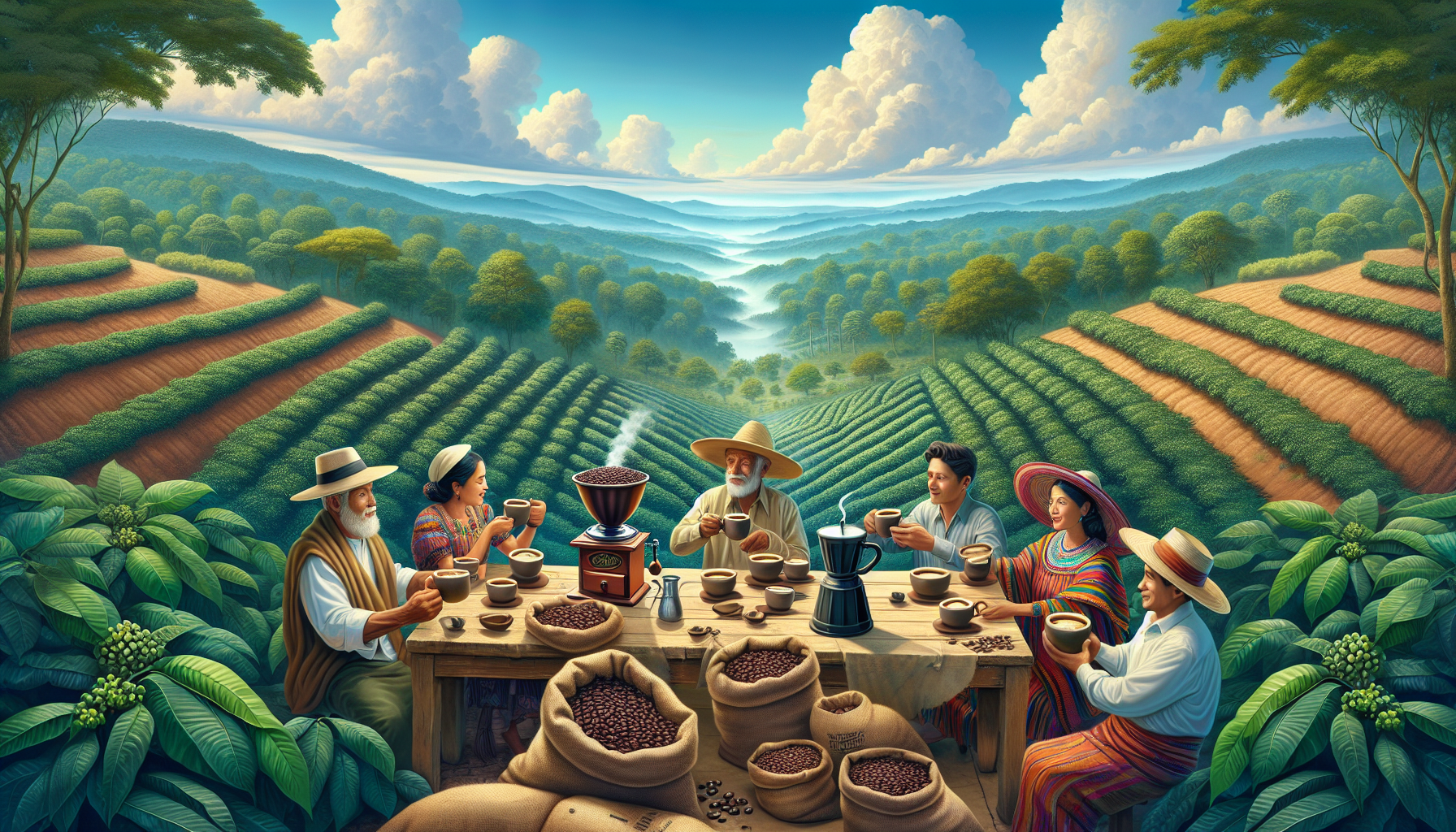If you’re a coffee lover looking to immerse yourself in Nicaragua’s rich coffee culture and experience the beauty of its coffee plantations, then you’re in for a treat. Nicaragua, known for its exceptional coffee, offers a unique opportunity for coffee enthusiasts to explore the intricacies of coffee production and witness the journey from bean to cup. From sampling freshly brewed coffee to taking scenic tours of lush plantations, there are endless ways to satisfy your caffeine cravings and indulge in the aromas and flavors of this beloved beverage in the heart of Central America. So grab your favorite mug and get ready to embark on a captivating coffee adventure in Nicaragua.

Understanding Nicaragua’s Coffee Culture
Nicaragua’s coffee culture is deeply ingrained in its history and daily life. Coffee holds a special place in the hearts of Nicaraguans, and it has become an integral part of their culture and identity. From its importance in social gatherings to its impact on the economy, coffee plays a significant role in the lives of the people of Nicaragua.
The Importance of Coffee in Nicaraguan Culture
Coffee is more than just a beverage in Nicaragua; it is a symbol of hospitality, community, and tradition. Nicaraguans take great pride in their coffee, and it is not uncommon for friends and family to gather for coffee breaks throughout the day. Coffee acts as a catalyst for conversations and strengthening relationships.
In addition to its cultural significance, the coffee industry is a crucial part of Nicaragua’s economy. The country is known for producing high-quality Arabica beans, which are in high demand worldwide. Coffee production provides employment for many Nicaraguans, and the revenue generated from coffee exports contributes significantly to the country’s economy.
History of Coffee Production in Nicaragua
Coffee production in Nicaragua dates back to the early 19th century when it was introduced by European settlers. The fertile volcanic soil and ideal climate created perfect conditions for coffee cultivation. Over the years, coffee has become one of Nicaragua’s primary agricultural exports, with coffee farms spread across different regions of the country.
Throughout its history, Nicaragua has faced challenges in the coffee industry, including political and economic instability. However, the determination and resilience of coffee farmers have allowed them to overcome these obstacles and establish Nicaragua as a prominent player in the global coffee market.
Types of Coffee Grown in Nicaragua
Nicaragua is known for producing several varieties of coffee, each with unique flavors and characteristics. The most common type of coffee grown in Nicaragua is Arabica, known for its smooth, mild flavor and delicate aroma. Within the Arabica family, you can find sub-varieties such as Typica, Catuai, and Bourbon, each offering distinct taste profiles.
Coffee cultivation in Nicaragua is region-specific, and each region produces coffee with its own distinct flavor. Some of the notable coffee regions in Nicaragua include Matagalpa, Jinotega, Nueva Segovia, and Estelí. Exploring these different regions will allow you to experience the diverse flavors and complexities of Nicaraguan coffee.

Planning Your Visit to Nicaragua
If you are eager to immerse yourself in Nicaragua’s coffee culture and explore its coffee plantations, proper planning is essential. Here are some key considerations to keep in mind before embarking on your Nicaraguan coffee adventure.
Choosing the Right Time to Visit
Nicaragua offers a year-round favorable climate for coffee cultivation, but if you want to witness the coffee harvest and immerse yourself in the vibrant coffee culture, the best time to visit is during the harvest season, which typically takes place between November and February.
Researching Coffee Regions in Nicaragua
With numerous coffee-growing regions in Nicaragua, it is crucial to research and determine which areas align with your preferences and interests. Each region has its own unique characteristics and offerings, so studying up on the different coffee regions will help you decide where to focus your visit.
Arranging Accommodation near Coffee Plantations
To make the most of your coffee exploration, consider staying near coffee plantations or in coffee-producing regions. This will allow you to wake up to the aroma of fresh coffee, engage with the farming community, and have easy access to plantation tours.
Getting to Nicaragua
Getting to Nicaragua is relatively straightforward, with international flights to the country readily available. Once you have arrived, you can easily navigate within Nicaragua using various transportation options.
International Flights to Nicaragua
The main international airport in Nicaragua is Augusto C. Sandino International Airport, located near the capital city of Managua. Multiple airlines offer flights to Nicaragua from various destinations worldwide. It is advisable to book your flights well in advance to secure the best deals and availability.
Domestic Travel within Nicaragua
After landing in Managua, you have several options for traveling to different coffee regions within Nicaragua. Domestic flights, although limited, are available and provide a convenient way to reach destinations further away. Alternatively, you can opt for buses, taxis, or rental cars to explore the country at your own pace.
Public Transportation Options
Nicaragua has an extensive network of public buses that connect different cities and regions. While the buses may not be the most luxurious option, they offer an affordable means of transportation. Additionally, taxis and shared shuttles are widely available and can be a convenient way to get around, especially for shorter distances.

Exploring Coffee Plantations
To truly understand Nicaragua’s coffee culture, visiting coffee plantations is a must. Here are some factors to consider when planning your visits to coffee plantations.
Popular Coffee Plantations for Tourists
Nicaragua offers several coffee plantations that warmly welcome tourists and provide educational and enriching experiences. Some popular plantations include Selva Negra, La Bastilla, and Las Flores. Each plantation has its own unique charm and offers a glimpse into the coffee production process.
Guided Tours vs. Independent Exploration
When visiting coffee plantations, you have the option to join guided tours or explore independently. Guided tours often provide a comprehensive understanding of the plantation’s history, cultivation methods, and processing techniques. Alternatively, independent exploration allows for a more flexible and personalized experience.
Interacting with Coffee Farmers
One of the highlights of visiting coffee plantations in Nicaragua is the opportunity to interact with coffee farmers themselves. Engaging in conversations with these passionate individuals will provide insights into their daily lives, challenges they face, and their deep-rooted connection to the land they cultivate.
Learning About Coffee Production Process
Understanding the coffee production process is a vital aspect of exploring Nicaragua’s coffee culture. Here are the key steps involved in bringing coffee from the farms to your cup.
Coffee Harvesting Techniques
Coffee cherries are harvested when they reach their peak ripeness. This is typically done by hand-selecting the cherries, ensuring that only the fully ripe ones are picked. The process requires skill and precision to ensure the quality of the beans.
Coffee Processing Methods
After harvesting, the coffee cherries undergo several processing methods, including the wet and dry methods. The wet method involves fermenting, washing, and drying the beans, while the dry method simply involves sun-drying the cherries. Each method imparts unique flavors to the coffee beans.
Coffee Roasting and Tasting
Roasting is a crucial step that transforms the raw coffee beans into the aromatic brown beans we are familiar with. This step is where the flavors and aromas develop. Once roasted, the coffee is ready for tasting, allowing coffee enthusiasts to appreciate the nuances and complexities of Nicaraguan coffee.

Experiencing Coffee Tastings
No exploration of Nicaragua’s coffee culture is complete without experiencing coffee tastings. Here are some ways to indulge in the flavors of Nicaraguan coffee.
Visiting Coffee Shops and Cafés in Nicaragua
Coffee shops and cafés in Nicaragua serve as hubs for coffee lovers to savor their favorite brews. These establishments offer a wide range of coffee options, showcasing the diversity and quality of Nicaraguan coffee. Take the time to enjoy a cup or two in these cozy settings.
Participating in Cupping Sessions
Cupping sessions provide an excellent opportunity to delve deeper into the nuances of coffee flavors and aromas. These sessions involve evaluating different coffees in a systematic manner, focusing on the different taste attributes such as acidity, body, and aftertaste.
Trying Different Coffee Brewing Methods
Nicaragua’s coffee culture extends beyond the traditional brewing methods. Explore different brewing techniques, such as the pour-over, French press, or aeropress, to appreciate how each method brings out different characteristics in the coffee.
Immersing in Local Coffee Culture
To fully immerse yourself in Nicaragua’s coffee culture, it is essential to engage with the local community and embrace their coffee traditions. Here are some ways to do so.
Attending Coffee Festivals and Events
Nicaragua hosts a variety of coffee festivals and events throughout the year, celebrating all things coffee. These gatherings provide opportunities to witness coffee competitions, participate in workshops, and engage with fellow coffee enthusiasts.
Engaging with Coffee Industry Experts
Seeking out coffee industry experts in Nicaragua will allow you to learn from their deep knowledge and expertise. Whether it’s joining a coffee workshop led by a seasoned barista or chatting with a coffee farmer, these interactions will enhance your understanding of the coffee industry.
Learning Nicaraguan Coffee Etiquette
Every culture has its unique coffee etiquette, and Nicaragua is no exception. Learning and practicing Nicaraguan coffee etiquette, such as the proper way to hold a coffee cup or offering a polite gesture before taking a sip, will show respect for the local customs and traditions.

Exploring Other Attractions in Nicaragua
While coffee tourism is a significant draw to Nicaragua, the country offers a plethora of other attractions that are worth exploring. Here are a few highlights.
Exploring Volcanoes and Natural Landscapes
Nicaragua is home to a stunning array of volcanoes and natural landscapes. Hike up the towering volcanoes such as Masaya or Mombacho for breathtaking views, or visit nature reserves like Ometepe Island to immerse yourself in the country’s natural beauty.
Visiting Colonial Cities and Architecture
The colonial cities of Granada and León are brimming with rich history and architectural marvels. Marvel at the Spanish colonial architecture, visit ancient cathedrals, and wander through the vibrant streets to soak up the colonial charm that is still prevalent in these cities.
Enjoying Nicaragua’s Beautiful Beaches
Nicaragua boasts gorgeous beaches along its Pacific coast, offering a haven for relaxation and water activities. From popular beach towns like San Juan del Sur to secluded gems like Playa Maderas, there is a beach to satisfy every beach lover’s preferences.
Supporting Sustainable Coffee Practices
As a conscious traveler, it is essential to support sustainable coffee practices during your visit to Nicaragua. Here are some ways to make a positive impact.
Choosing Fair Trade and Organic Coffee
When purchasing coffee, opt for fair trade and organic options. Fair trade certification ensures that coffee farmers receive fair wages and work in humane conditions, while organic certification promotes environmentally-friendly cultivation practices.
Understanding the Impact of Coffee Production on the Environment
Coffee production can have environmental implications, such as deforestation and water pollution. Educate yourself on the environmental impact of coffee production and choose coffee from farms that prioritize sustainability, conservation, and responsible farming practices.
Supporting Local Coffee Farmers and Cooperatives
Directly supporting local coffee farmers and cooperatives is a meaningful way to contribute to the sustainability of the coffee industry. Look for opportunities to purchase coffee directly from farmers or cooperatives, ensuring that your money goes directly to the communities that grow and cultivate the coffee.
Bringing Home Nicaraguan Coffee Souvenirs
As you bid farewell to Nicaragua, bring a piece of its coffee culture home with you by purchasing coffee beans and unique coffee-related souvenirs.
Purchasing Coffee Beans from Plantations
Many coffee plantations in Nicaragua offer the opportunity to purchase freshly roasted beans. Take advantage of this and bring home some of the finest Nicaraguan coffee beans, allowing you to enjoy the flavors and aromas of Nicaragua long after your trip.
Finding Unique Coffee-related Souvenirs
Beyond coffee beans, you may find unique coffee-related souvenirs to treasure as reminders of your Nicaraguan coffee adventure. Handcrafted coffee mugs, traditional coffee grinders, or artwork inspired by coffee are just a few examples of the distinctive souvenirs you can find.
Learning How to Brew Nicaraguan Coffee at Home
While in Nicaragua, take the time to learn about the traditional brewing methods and techniques used by local coffee farmers. Armed with this knowledge, you can continue to brew authentic Nicaraguan coffee in the comfort of your own home, keeping the memories of your trip alive with every cup.
By understanding Nicaragua’s coffee culture, planning your visit, and immersing yourself in the local traditions, you can fully explore the rich world of Nicaraguan coffee and create memories that will last a lifetime. So, grab a cup of Nicaraguan coffee, embrace the warmth of the culture, and embark on this extraordinary coffee journey through beautiful Nicaragua.
